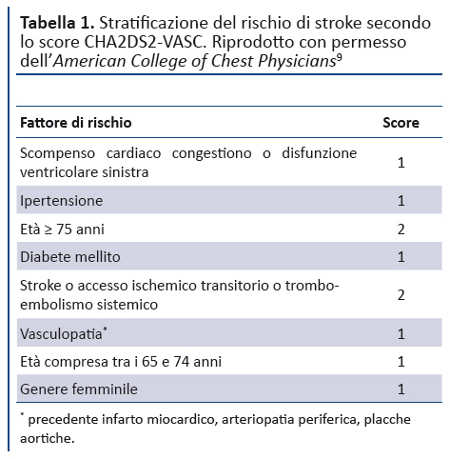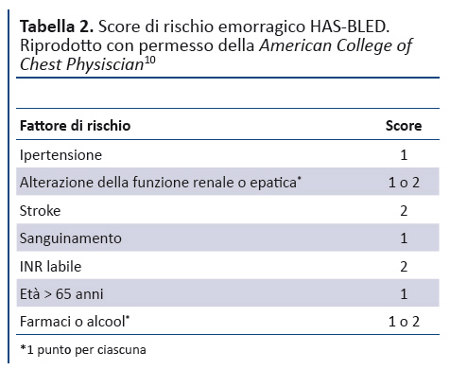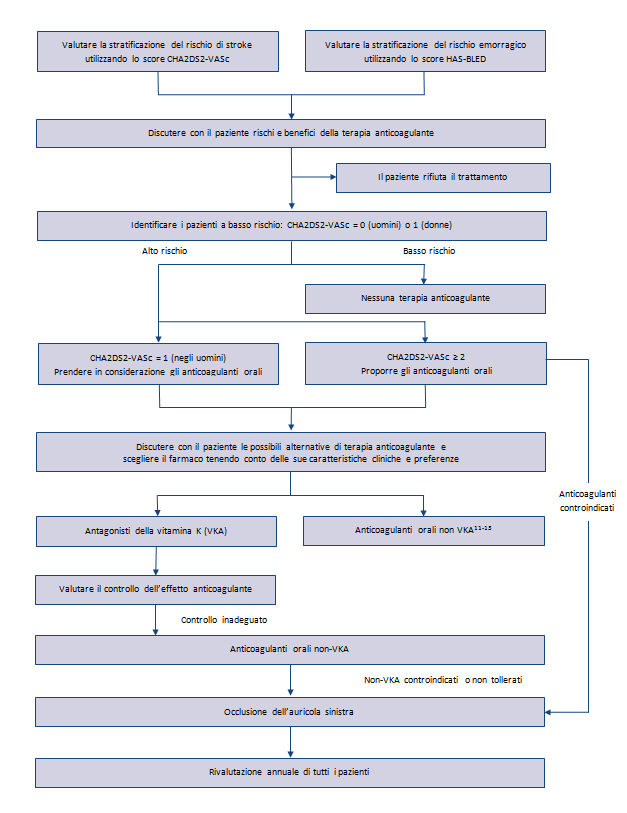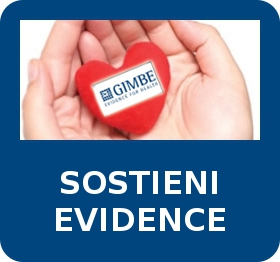Best practice
Evidence 2014;6(6): e1000083 doi: 10.4470/E1000083
Pubblicato: 26 giugno 2014
Copyright: © 2014 Cartabellotta. Questo è un articolo open-access, distribuito con licenza Creative Commons Attribution, che ne consente l’utilizzo, la distribuzione e la riproduzione su qualsiasi supporto esclusivamente per fini non commerciali, a condizione di riportare sempre autore e citazione originale.
La fibrillazione atriale (FA) è una condizione sempre più frequente la cui incidenza, prevalenza e mortalità associate sono aumentate nel periodo 1990-2010 (1). Molti pazienti vengono gestiti a livello di cure primarie senza un coinvolgimento diretto degli ospedali. La FA è una causa importante di morbilità , in particolare di stroke, e riduce l’aspettativa di vita. Anche se lo stroke causato dalla FA può essere ampiamente prevenuto con la terapia anticoagulante, l’assunzione di questo trattamento da parte di pazienti con diagnosi di FA a rischio di stroke è ancora subottimale (2-5).
Dalla pubblicazione delle linee guida del 2006 sono emerse numerose evidenze che ne rendono opportuno un aggiornamento: stratificazione del rischio, prevenzione dello stroke, gestione dell’aritmia, sviluppi della terapia farmacologica e interventistica.
Questo articolo sintetizza le più recenti raccomandazioni del National Institute for Health and Care Excellence (NICE) (6). Le raccomandazioni del NICE sono basate su una revisione sistematica delle migliori evidenze disponibili e sull’esplicita considerazione della costo-efficacia degli interventi sanitari. Quando le evidenze sono limitate, le raccomandazioni si basano sull’esperienza del gruppo che ha prodotto la linea guida – Guidelines Development Group (GDG) – e sulle norme di buona pratica clinica. I livelli di evidenza delle raccomandazioni cliniche sono indicati in corsivo tra parentesi quadre. Tutte le raccomandazioni dovrebbero essere adottate in accordo alle linee guida NICE relative all’esperienza di malattia del paziente (7) e i benefici e i rischi del trattamento dovrebbero comunque sempre essere discussi con il paziente.
1. Diagnosi e valutazione
- Rilevare manualmente il polso periferico per evidenziare la presenza di pulsazioni irregolari che potrebbero indicare una FA nei soggetti che si presentano con uno dei seguenti sintomi: affanno o dispnea, palpitazioni, sincope o vertigini, dolore toracico, segni clinici compatibili con stroke o attacco ischemico transitorio.
- Eseguire un elettrocardiogramma (ECG) in tutte i soggetti, sintomatici o meno, nei quali la rilevazione del polso periferico ha generato il sospetto clinico di FA.
- Nei soggetti con sospetto di FA parossistica non rilevata dall’ECG standard:
- eseguire un ECG Holter 24 ore nei pazienti asintomatici o in quelli sintomatici con intervallo degli episodi di aritmia inferiori alle 24 ore
- eseguire un ECG con registrazione degli eventi nei pazienti sintomatici con intervallo degli episodi di aritmia oltre le 24 ore
[Raccomandazioni basate sull’esperienza e l’opinione del GDG]
2. Piano di cura personalizzato
- Proporre a tutti i pazienti con FA un piano di cura personalizzato (box), assicurandosi che sia adeguatamente documentato e consegnato a tutti i pazienti. [Raccomandazione basata su evidenze da trial controllati randomizzati di qualità molto bassa e moderata e sull’esperienza e l’opinione del GDG]
|
Box. Piano di cura personalizzato
|
3. Invio allo specialista
Inviare tempestivamente allo specialista i pazienti con FA a qualunque stadio della malattia se la terapia non controlla i sintomi dell’aritmia e si rende necessaria una gestione più specialistica. Per invio tempestivo si intende un intervallo =4 settimane dall’ultimo trattamento non efficace o =4 settimane dalla recidiva di FA dopo cardioversione, per la quale diventa necessaria una gestione specialistica. [Raccomandazione basata su evidenze da trial controllati randomizzati di qualità da bassa ad alta, su valutazioni economiche con potenziali serie limitazioni ed applicabilità parziale e sull’esperienza e l’opinione del GDG]
4. Valutazione del rischio di stroke e del rischio emorragico In tutti i pazienti con FA dovrebbero essere valutati il rischio di stroke e quello emorragico.
- Utilizzare lo score CHA2DS2-VASc (tabella 1) (9) per valutare il rischio di stroke nei pazienti che presentano una delle seguenti condizioni:
- FA parossistica sintomatica o asintomatica, persistente o permanente
- flutter atriale
- rischio continuo di recidiva dell’aritmia dopo cardioversione a ritmo sinusale
- Utilizzare lo score HAS-BLED (10) (tabella 2) per valutare il rischio di sanguinamento nei pazienti che devono iniziare/hanno iniziato la terapia anticoagulante e per evidenziare, correggere e monitorare i fattori di rischio modificabili:
- ipertensione non controllata
- INR (international normalized ratio) “labile”, ossia scarsamente controllato
- concomitante assunzione di altri farmaci, come aspirina o FANS
- iperconsumo di alcool
- Al momento di discutere rischi e benefici della terapia anticoagulante tenere conto che:
- per la maggior parte dei pazienti i benefici della terapia anticoagulante sono superiori ai rischi di sanguinamento
- nei pazienti con aumento del rischio di emorragia i benefici della terapia anticoagulante potrebbero non essere sempre superiori al rischio emorragico, il cui attento monitoraggio è particolarmente rilevante
- Non escludere la terapia anticoagulante solo perché il paziente è a rischio di cadute. [Raccomandazione basata sull’esperienza e l’opinione del GDG]


5. Prevenzione farmacologica dello stroke (figura)
Questa revisione delle linee guida enfatizza la necessità di individuare immediatamente i soggetti a rischio molto basso di stroke che non dovrebbero essere trattati con anticoagulanti. Questa terapia deve invece essere presa in considerazione o prescritta a tutti gli altri pazienti, valutando sempre il rischio emorragico. L’anticoagulante può essere un antagonista della vitamina K per via orale (es. warfarin) o un farmaco non antagonista della vitamina K (apixaban, dabigatran etexilate, rivaroxaban, secondo le valutazioni del NICE (11-13)).
- Non sottoporre a terapia per la prevenzione dello stroke soggetti di età < 65 anni con FA e nessun fattore di rischio oltre al genere (ovvero a rischio molto basso pari ad uno score CHA2DS2-VASc di 0 per l’uomo e 1 per la donna)
- Prendere in considerazione la terapia anticoagulante orale negli uomini con score CHA2DS2-VASc pari a 1, valutando sempre il rischio emorragico.
- Prescrivere la terapia anticoagulante orale a pazienti con score CHA2DS2-VASc ≥ 2, tenendo sempre in considerazione il rischio emorragico.
[Raccomandazioni basate su evidenze da trial controllati randomizzati di qualità da molto bassa a alta, da studi economici con limiti potenziali da minimi a potenzialmente seri e applicabilità diretta o parziale, su una analisi economica diretta con limitazioni potenzialmente serie e applicabilità diretta, e sull’esperienza e l’opinione del GDG] - Discutere le opzioni della terapia anticoagulante orale con il paziente e scegliere tenendo conto delle sue caratteristiche cliniche e delle sue preferenze. [Raccomandazione basata sull’esperienza e l’opinione del GDG]
- Non somministrare ai pazienti con FA aspirina in monoterapia esclusivamente per la prevenzione dell’ictus. [Raccomandazione basata su evidenze da trial controllati randomizzati di qualità da molto bassa a alta, da studi economici con limiti potenziali da minimi a potenzialmente seri e applicabilità diretta o parziale, su una analisi economica diretta con limitazioni potenzialmente serie e applicabilità diretta, e sull’esperienza e l’opinione del GDG]

6. Monitoraggio dell’effetto anticoagulante degli antagonisti della vitamina K
Nei pazienti in terapia con antagonisti della vitamina K valutare l’effetto anticoagulante.
- Calcolare il TTR (time in therapeutic range) individuale ad ogni visita. Nel calcolare il TTR:
- utilizzare un metodo di calcolo validato (es. metodo di Rosendaal (14)) per il dosaggio automatizzato o, in caso di dosaggio eseguito manualmente, calcolare la proporzione dei test in range
- non considerare le misurazioni effettuate durante le prime 6 settimane di terapia
- calcolare il TTR per un periodo di terapia di almeno 6 mesi
[Raccomandazione basata sull’esperienza e l’opinione del GDG]
Nota: il TTR permette di valutare la qualità dell’effetto anticoagulante della terapia, ossia la proporzione di tempo durante il quale i valori di INR del paziente rientrano nei limiti terapeutici. Viene espresso in percentuale e presuppone un cambiamento di tipo lineare tra i risultati dell’INR. Un TTR elevato si associa a una riduzione degli eventi ischemici e trombotici.
- Rivalutare la terapia nei pazienti con scarso controllo dell’effetto anticoagulante indicato da:
- due valori di INR > 5 o un valore di INR > 8 negli ultimi 6 mesi
- due valori di INR < 1.5 negli ultimi 6 mesi
- TTR < 65%
[Raccomandazione basata sull’esperienza e l’opinione del GDG]
- Nel rivalutare la terapia anticoagulante, prendere in considerazione e, se possibile, correggere i seguenti fattori che potrebbero contribuire a scarso controllo dell’effetto anticoagulante:
- funzioni cognitive
- aderenza alla terapia prescritta
- malattie intercorrenti
- interazioni farmaciologiche
- stili di vita, inclusi dieta e assunzione di alcol
[Raccomandazione basata sull’esperienza l’opinione del GDG]
- Se non è possibile migliorare l’effetto anticolagulante, valutare rischi e benefici di altre strategie per prevenire lo stroke, tra cui gli anticoagulanti orali non antagonisti della vitamina K. [Raccomandazione basata sull’esperienza e l’opinione del GDG]
7. Rivalutazione del rischio di stroke e della terapia anticoagulante
Tutti i pazienti con FA dovrebbero essere rivalutati almeno una volta all’anno.
- Nei pazienti che non assumono anticoagulanti rivalutare il rischio di stroke al 65° anno di età o se il paziente sviluppa, a qualsiasi età , una delle seguenti condizioni:
diabete- scompenso cardiaco
- arteriopatia periferica
- malattia coronarica
- stroke, attacco ischemico transitorio o qualsiasi evento tromboembolico sistemico
- Nei pazienti che non assumono anticoagulanti rivalutare annualmente il rischio di stroke e quello emorragico. Assicurarsi che tutte le rivalutazioni e le decisioni vengano documentate.
- Nei pazienti in terapia anticoagulante rivalutare l’effettiva necessità di scoagulare il paziente e la qualità dell’effetto anticoagulante almeno una volta all’anno o più spesso in caso di eventi clinici rilevanti che possano influenzare l’efficacia dell’anticoagulante o modificare il rischio emorragico.
[Raccomandazioni basate sull’esperienza e l’opinione del GDG]
8. Occlusione dell’auricola atriale sinistra
Si tratta di una tecnica via catetere per la chiusura o obliterazione dell’auricola atriale sinistra, principale fonte di trombi causa di stroke e tromboembolismo periferico nei pazienti con FA.
- Considerare l’occlusione dell’auricola sinistra se la terapia anticoagulante è controindicata o non tollerata. [Raccomandazione basata su evidenze da trial controllati randomizzati di qualità da molto bassa a moderata, su evidenze di tipo economico con limitazioni minimali ed applicabilità parziale e sull’esperienza e l’opinione del GDG]
9. Controllo della frequenza e del ritmo
9.1. Terapia farmacologica
Al momento non ci sono evidenze che la strategia di controllo del ritmo sia più efficace di quella di controllo della frequenza per prevenire lo stroke o ridurre la mortalità . Pertanto, l’obiettivo principale della terapia è il controllo dei sintomi.
- La strategia di prima linea è il controllo della frequenza, a meno che il giudizio clinico non porti a preferire il controllo del ritmo (es. FA di recente insorgenza e FA con causa reversibile). [Raccomandazione basata su evidenze da trial controllati randomizzati di qualità da molto bassa a moderata, su evidenze di tipo economico con limitazioni da minimali a potenzialmente serie e applicabilità parziale e sull’esperienza e l’opinione del GDG]
- Ai pazienti con FA che necessitano di un trattamento farmacologico come parte della strategia di controllo della frequenza, proporre inizialmente una monoterapia con beta-bloccante (ad eccezione del sotalolo) o con calcio-antagonista ad effetto bradicardizzante. [Raccomandazione basata su evidenze da trial controllati randomizzati di qualità molto bassa e sull’esperienza e l’opinione del GDG]
- Considerare la monoterapia con digossina solo nei pazienti sedentari con FA non parossistica. [Raccomandazione basata su evidenze da trial controllati randomizzati di qualità da molto bassa a bassa e sull’esperienza e l’opinione del GDG]
- Se la monoterapia non controlla i sintomi e se il persistere della sintomatologia è imputabile a uno scarso controllo della frequenza ventricolare, prendere in considerazione una terapia combinata con due tra i seguenti farmaci: beta-bloccante, diltiazem, digossina. [Raccomandazione basata su evidenze da trial controllati randomizzati di qualità da molto bassa a bassa e sull’esperienza e l’opinione del GDG]
- Considerare una strategia farmacologica o elettrica (o entrambe) per controllare il ritmo nei pazienti con FA la cui sintomatologia continua anche dopo il controllo della frequenza cardiaca o quando la strategia di controllo della frequenza non è risultata efficace. [Raccomandazione basata su evidenze da trial controllati randomizzato di qualità da molto bassa ad elevata e sull’esperienza l’opinione del GDG]
- Valutare la necessità di terapia farmacologica a lungo termine per il controllo del ritmo. [Raccomandazione basata su evidenze da trial controllati randomizzati di qualità da molto bassa ad elevata e sull’esperienza e l’opinione del GDG]
Nota: la terapia farmacologica a lungo termine per il controllo del ritmo potrebbe essere necessaria per i pazienti con FA parossistica con l’obiettivo di prolungare la durata dei periodi in ritmo sinusale, oppure dopo la cardioversione per i pazienti con verosimile rischio di recidiva al fine di aumentare la probabilità di mantenere il ritmo sinusale. - Se è necessaria una terapia farmacologica a lungo termine per il controllo del ritmo, considerare inizialmente un beta-bloccante (ad eccezione del sotalolo) in assenza di controindicazioni (es. bradicardia eccessiva, asma, arteriopatia periferica). [Raccomandazione basata su evidenze da trial controllati randomizzati di qualità da molto bassa ad elevata e sull’esperienza e l’opinione del GDG]
- Se la terapia con beta-bloccante è controindicata o non risulta efficace, valutare altri farmaci per il controllo del ritmo, tenendo in considerazione le eventuali comorbidità . [Raccomandazione basata su evidenze da trial controllati randomizzati di qualità da molto bassa ad elevata e sull’esperienza e l’opinione del GDG]
9.2. Terapia non farmacologica
Se il trattamento farmacologico non funziona, l’ablazione atriale sinistra è un’opzione efficace, in particolare se effettuato precocemente e nei pazienti con FA parossistica, piuttosto che in quella persistente. Il pacing atriale dopo ablazione del nodo atrioventricolare è un opzione alternativa all’ablazione atriale sinistra. Questo trattamento non ripristina il ritmo sinusale, ma riduce in maniera efficace la frequenza ventricolare.
- Se il trattamento farmacologico è inefficace per controllare i sintomi della FA, oppure non è raccomandato:
- nei pazienti con FA parossistica eseguire l’ablazione atriale sinistra transcatetere
- nei pazienti con FA persistente considerare l’ablazione atriale sinistra via catetere oppure chirurgica
- |Nei pazienti con FA sintomatica sottoposti a interventi necessari di chirurgica cardiotoracica, considerare la contemporanea ablazione atriale sinistra chirurgica.[Raccomandazioni basate su evidenze da trial controllati randomizzati di qualità da molto bassa a moderata, su evidenze di tipo economico con limitazioni potenzialmente serie ed applicabilità diretta o parziale e sull’esperienza e l’opinione del GDG]
- Nei pazienti con FA permanente e sintomi di disfunzione ventricolare sinistra attribuibili a frequenza ventricolare elevata, considerare l’ablazione del nodo atrioventricolare con pacing. [Raccomandazione basata su evidenze da trial controllati randomizzati di qualità da molto bassa a moderata e sull’esperienza e l’opinione del GDG]
- Quando si prende in considerazione l’ablazione del nodo atrioventricolare con pacing, rivalutare la sintomatologia e l’indicazione all’ablazione dopo aver eseguito il pacing e ottimizzato ulteriormente la terapia farmacologica. [Raccomandazione basata su evidenze da trial controllati randomizzati di qualità da molto bassa a moderata e sull’esperienza e l’opinione del GDG]
10. Potenziali ostacoli all’implementazione
Nei pazienti con FA la terapia anticoagulante è sotto-utilizzata (4,5). In particolare negli anziani l’aspirina viene spesso preferita agli anticoagulanti (3) anche se questi ultimi, rispetto all’aspirina, riducono di circa il 50% il rischio di stroke (15). Riteniamo che questa linea guida aiuti a risolvere questi problemi attraverso un cambio di paradigma, identificando i pazienti a basso rischio per i quali la terapia anticoagulante non è indicata e chiarendo definitivamente il concetto che l’aspirina non è un’alternativa costo-efficace.
11. Raccomandazioni per la ricerca futura
Il GDG ha identificato le seguenti prioritĂ di ricerca:
- Nei pazienti con FA di nuova diagnosi qual è l’efficacia e la costo-efficacia della terapia cognitivo-comportamentale rispetto all’assitenza tradizionale?
- Nei pazienti di etĂ ≥ 75 anni qual è l’efficacia comparativa delle tre principali classi di farmaci per il controllo della frequenza (beta-bloccanti, calcio antagonisti, digossina) su controllo dei sintomi, qualitĂ di vita e riduzione di morbiditĂ e mortalitĂ ?
- Quali sono le eventuali correlazioni tra esiti e complicanze in base al numero di procedure di ablazione atriale via catetere?
- I pazienti con FA in cui l’effetto anticoagulante del warfarin è, o si prevede che sia, inadeguato, traggono beneficio dagli anticogulanti orali non antagonisti della vitamina K?
- I dati continuamente inseriti nei database dei medici di medicina generale possono chiarire meglio il rischio di stroke nei pazienti con FA in relazione ai fattori di rischio e al trattamento in corso?
Contributo degli Autori
-Disclosure dei conflitti di interesse
Antonino Cartabellotta è il Presidente della Fondazione GIMBE, organizzazione no-profit che svolge attività di formazione e ricerca su alcune tematiche trattate nell’articoloIndirizzo per la corrispondenza
nino.cartabellotta@gimbe.orgProvenienza
Non commissionato, non sottoposto a peer-reviewFonti di finanziamento
NessunaApprovazione comitato etico
-Pagina aggiornata il 26/giugno/2014



